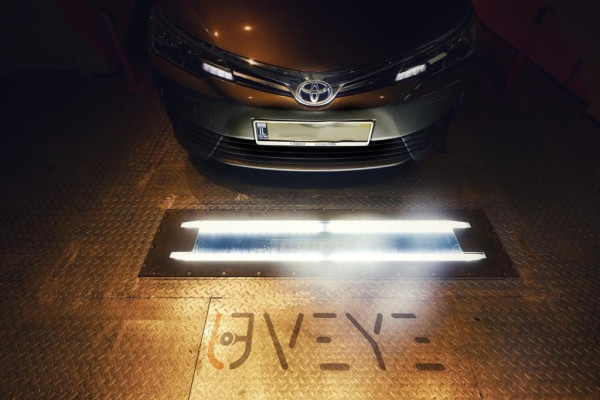The race is on for the car of the future, equipped with self-driving capabilities, on-board personalised information and entertainment, and an ever-smaller carbon footprint. Today, however, comes news of a startup that’s improving car performance from the outside.
UVeye, a Tel Aviv-based company that has built a set of drive-through external scanners that can take images of the exterior of a vehicle (including the tires and undercarriage) and then — using computer vision and AI — instantly read those scans to detect for anomalies, has raised $31 million in funding, money that it will be using to continue expanding its technology, as well as building out the rest of its business.
Today, UVeye is already finding applications in assessing the state of rental and used cars, helping with insurance adjustments, inspecting vehicles to diagnose mechanical or other problems, and as part of wider security efforts. Its customers include car giants, their OEM partners, insurance companies, security services and governments, rental companies, on-demand ride-hailing companies, and many others in the transportation industry whose businesses are based on maintaining or inspecting vehicles.
Amir Hever, the CEO and co-founder, noted that while there are, for example, six OEMs already working with his company, there is also a long waiting list of companies that want to work with the startup. So this is part of the reason for the funding, too: to scale up and meet that demand.
The key to UVeye is that its vertically-integrated system (which includes the scanning hardware as well as the software to read and understand the scans) is fully automated. “We give accurate reports of vehicle based on AI algorithms that are very accurate and will produce consistent results every time,” said Hever. “It’s harder to do this many inspections today because they are basically human based.”
Toyota Tsusho, Volvo Cars and previous investor W. R. Berkley Corporation are leading this round, along with another returning investor, F.I.T. Ventures, and others — strategic partners that underscore the company’s progress so far, and what trajectory it would like to follow.
UVeye said that Toyota Tsusho (a member of the Toyota Group that provides a number of car-related services such as exporting, alongside non-automotive interests) will be using its technology in used car centers and the wider automotive trading market. Volvo will be rolling UVeye out in its factories, dealerships and for aftermarket support — or “whole lifecycle” management, in the words of Hever. And W. R. Berkeley, an insurance company, has been working on business models incorporating the use of UVeye’s scanning technology to help with registrations and subsequent claims, as well as those security applications.
This funding is the first significant money that the startup has raised and brings the total raised by UVeye to about $35 million. Its strategic partners include Daimler and Skoda. (Impressive to note the traction so far, in fact, on so little capital.)
“Premium quality standards are at the core of the Volvo brand and we are intrigued by the possibilities that UVeye’s technology offers,” Zaki Fasihuddin, CEO of the Volvo Cars Tech Fund said in a statement. “This type of advanced scanning technology could allow us to take the next step in quality.”
“When we made our initial investment in UVeye two years ago, we believed its system could have game-changing impact within security and inspection applications globally,” said Mike Nannizzi, director of fintech investments at W. R. Berkley Corporation, in a statement. “Today’s announcement validates that early hypothesis. We congratulate UVeye, Toyota Tsusho and Volvo Cars for building a cohesive partnership with enormous potential.”
UVeye’s technology is aiming to replace — or at least augment — a very antiquated and analog way of inspecting cars from the outside. Typically and traditionally, inspections are done by human mechanics, who then compare their findings against previous human-made assessments to identify issues. The vehicle also needs to be completely stationary during these checks. The whole process can take hours or days.
UVeye brings that down to seconds, Hever said. Currently a car can be moving up to 20 miles per hour and still be “read” as well as a car that is stationary, with the size of cosmetic anomalies — scratches and the like — capable of being as small as 2 millimeters in size. The system continues to get optimized all the time, Hever added.
Today the company continues to focus on vertical integration — that is, UVeye manufactures all its own hardware as well as develops the software that runs on it. I asked if at any point it might be able to work with the kind of camera you might typically find on a smartphone. These are improving all the time, and they are already being used as portable computers by, for example, customer service assistants at rental agencies to check-in vehicles after they have been returned by customers.
Hever said that while this may be the case, the aim for his company is to fully automate the inspection to the point that no human would need to be involved at all in that aspect.
“The market has really improved and cameras are chaning all the time,” said Hever, “But what is unique about our solution is that we are trying to make them automated.”
So, for example, scanning points could be set up at the car rental entrance / exit point to automatically take in the car details before and after it’s been used — or equally on an assembly line of a car maker or at an inspection station for an insurance company, eliminating the need for manual operators. (This obviously presents a higher IT cost to the customer, of course, although it might be justified by reducing the number of customer service agents that need to be on the payroll, and more importantly speed up the procurement and return of cars.)
Longer term, the plan will be to continue expanding UVeye’s capabilities and applications, as well as business partners. The possibilities for what it might tackle next are very interesting:
Tapping into the rise of autonomous vehicle technologies, one area that UVeye is starting to explore is how its exterior system might better communicate with the kinds of diagnostics that a car’s own internal systems are producing, to provide even more accurate assessments of problems a car might be having. (For example, in the case of engine problems and leaks, or small cracks in some of the parts, or problems with tires.)
And UVeye’s platform could potentially include expand to scanning what might be on the inside as well as the outside. Today, a lot of this is done with x-rays but there are new technologies involving sound waves and other parameters to be able to identify and verify cargo shipments — which could take the company into other verticals around shipping and logistics, as well as become even more relevant to security inspections.










